Rohan Pandey
gzip Predicts Data-dependent Scaling Laws
May 26, 2024Abstract:Past work has established scaling laws that predict the performance of a neural language model (LM) as a function of its parameter count and the number of tokens it's trained on, enabling optimal allocation of a fixed compute budget. Are these scaling laws agnostic to training data as some prior work suggests? We generate training datasets of varying complexities by modulating the syntactic properties of a PCFG, finding that 1) scaling laws are sensitive to differences in data complexity and that 2) gzip, a compression algorithm, is an effective predictor of how data complexity impacts scaling properties. We propose a new data-dependent scaling law for LM's that accounts for the training data's gzip-compressibility; its compute-optimal frontier increases in dataset size preference (over parameter count preference) as training data becomes harder to compress.
Towards Vision-Language Mechanistic Interpretability: A Causal Tracing Tool for BLIP
Aug 27, 2023



Abstract:Mechanistic interpretability seeks to understand the neural mechanisms that enable specific behaviors in Large Language Models (LLMs) by leveraging causality-based methods. While these approaches have identified neural circuits that copy spans of text, capture factual knowledge, and more, they remain unusable for multimodal models since adapting these tools to the vision-language domain requires considerable architectural changes. In this work, we adapt a unimodal causal tracing tool to BLIP to enable the study of the neural mechanisms underlying image-conditioned text generation. We demonstrate our approach on a visual question answering dataset, highlighting the causal relevance of later layer representations for all tokens. Furthermore, we release our BLIP causal tracing tool as open source to enable further experimentation in vision-language mechanistic interpretability by the community. Our code is available at https://github.com/vedantpalit/Towards-Vision-Language-Mechanistic-Interpretability.
Athena 2.0: Discourse and User Modeling in Open Domain Dialogue
Aug 03, 2023



Abstract:Conversational agents are consistently growing in popularity and many people interact with them every day. While many conversational agents act as personal assistants, they can have many different goals. Some are task-oriented, such as providing customer support for a bank or making a reservation. Others are designed to be empathetic and to form emotional connections with the user. The Alexa Prize Challenge aims to create a socialbot, which allows the user to engage in coherent conversations, on a range of popular topics that will interest the user. Here we describe Athena 2.0, UCSC's conversational agent for Amazon's Socialbot Grand Challenge 4. Athena 2.0 utilizes a novel knowledge-grounded discourse model that tracks the entity links that Athena introduces into the dialogue, and uses them to constrain named-entity recognition and linking, and coreference resolution. Athena 2.0 also relies on a user model to personalize topic selection and other aspects of the conversation to individual users.
Multimodal Learning Without Labeled Multimodal Data: Guarantees and Applications
Jun 07, 2023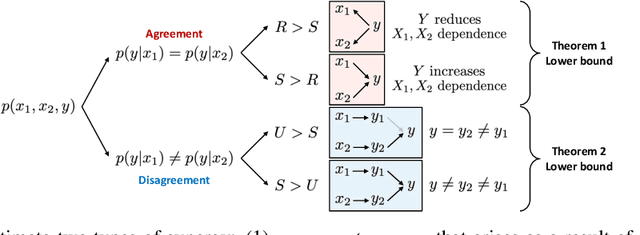
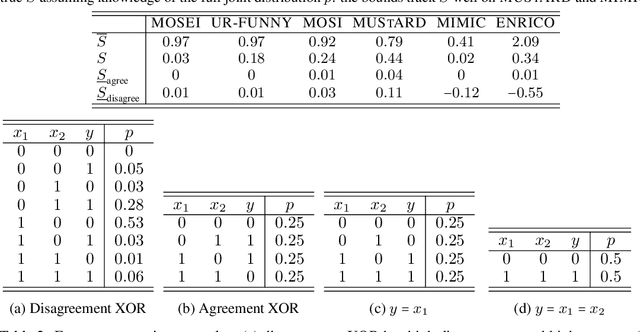
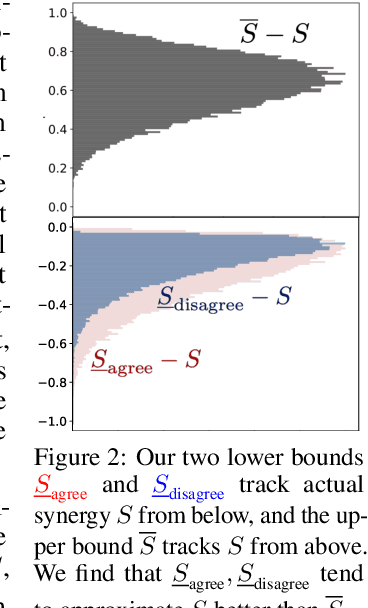

Abstract:In many machine learning systems that jointly learn from multiple modalities, a core research question is to understand the nature of multimodal interactions: the emergence of new task-relevant information during learning from both modalities that was not present in either alone. We study this challenge of interaction quantification in a semi-supervised setting with only labeled unimodal data and naturally co-occurring multimodal data (e.g., unlabeled images and captions, video and corresponding audio) but when labeling them is time-consuming. Using a precise information-theoretic definition of interactions, our key contributions are the derivations of lower and upper bounds to quantify the amount of multimodal interactions in this semi-supervised setting. We propose two lower bounds based on the amount of shared information between modalities and the disagreement between separately trained unimodal classifiers, and derive an upper bound through connections to approximate algorithms for min-entropy couplings. We validate these estimated bounds and show how they accurately track true interactions. Finally, two semi-supervised multimodal applications are explored based on these theoretical results: (1) analyzing the relationship between multimodal performance and estimated interactions, and (2) self-supervised learning that embraces disagreement between modalities beyond agreement as is typically done.
Semantic Composition in Visually Grounded Language Models
May 15, 2023Abstract:What is sentence meaning and its ideal representation? Much of the expressive power of human language derives from semantic composition, the mind's ability to represent meaning hierarchically & relationally over constituents. At the same time, much sentential meaning is outside the text and requires grounding in sensory, motor, and experiential modalities to be adequately learned. Although large language models display considerable compositional ability, recent work shows that visually-grounded language models drastically fail to represent compositional structure. In this thesis, we explore whether & how models compose visually grounded semantics, and how we might improve their ability to do so. Specifically, we introduce 1) WinogroundVQA, a new compositional visual question answering benchmark, 2) Syntactic Neural Module Distillation, a measure of compositional ability in sentence embedding models, 3) Causal Tracing for Image Captioning Models to locate neural representations vital for vision-language composition, 4) Syntactic MeanPool to inject a compositional inductive bias into sentence embeddings, and 5) Cross-modal Attention Congruence Regularization, a self-supervised objective function for vision-language relation alignment. We close by discussing connections of our work to neuroscience, psycholinguistics, formal semantics, and philosophy.
Syntax-guided Neural Module Distillation to Probe Compositionality in Sentence Embeddings
Jan 21, 2023Abstract:Past work probing compositionality in sentence embedding models faces issues determining the causal impact of implicit syntax representations. Given a sentence, we construct a neural module net based on its syntax parse and train it end-to-end to approximate the sentence's embedding generated by a transformer model. The distillability of a transformer to a Syntactic NeurAl Module Net (SynNaMoN) then captures whether syntax is a strong causal model of its compositional ability. Furthermore, we address questions about the geometry of semantic composition by specifying individual SynNaMoN modules' internal architecture & linearity. We find differences in the distillability of various sentence embedding models that broadly correlate with their performance, but observe that distillability doesn't considerably vary by model size. We also present preliminary evidence that much syntax-guided composition in sentence embedding models is linear, and that non-linearities may serve primarily to handle non-compositional phrases.
Cross-modal Attention Congruence Regularization for Vision-Language Relation Alignment
Dec 20, 2022



Abstract:Despite recent progress towards scaling up multimodal vision-language models, these models are still known to struggle on compositional generalization benchmarks such as Winoground. We find that a critical component lacking from current vision-language models is relation-level alignment: the ability to match directional semantic relations in text (e.g., "mug in grass") with spatial relationships in the image (e.g., the position of the mug relative to the grass). To tackle this problem, we show that relation alignment can be enforced by encouraging the directed language attention from 'mug' to 'grass' (capturing the semantic relation 'in') to match the directed visual attention from the mug to the grass. Tokens and their corresponding objects are softly identified using the cross-modal attention. We prove that this notion of soft relation alignment is equivalent to enforcing congruence between vision and language attention matrices under a 'change of basis' provided by the cross-modal attention matrix. Intuitively, our approach projects visual attention into the language attention space to calculate its divergence from the actual language attention, and vice versa. We apply our Cross-modal Attention Congruence Regularization (CACR) loss to UNITER and improve on the state-of-the-art approach to Winoground.
Athena 2.0: Contextualized Dialogue Management for an Alexa Prize SocialBot
Nov 03, 2021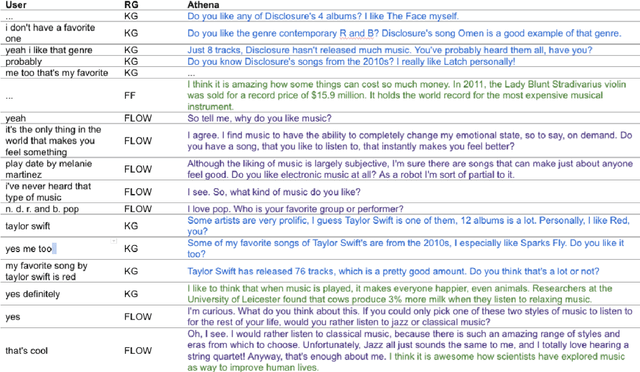
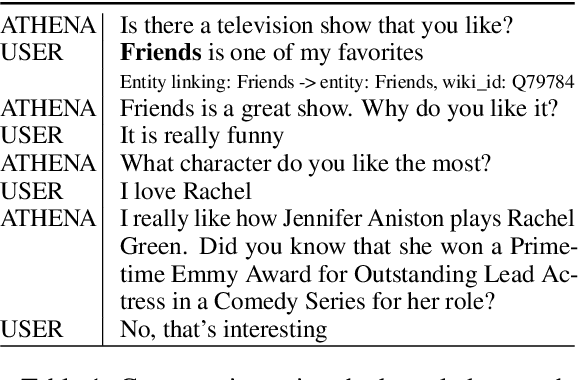
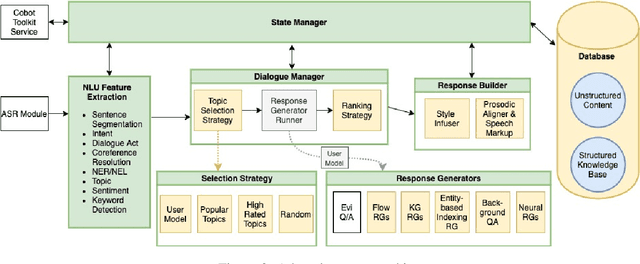
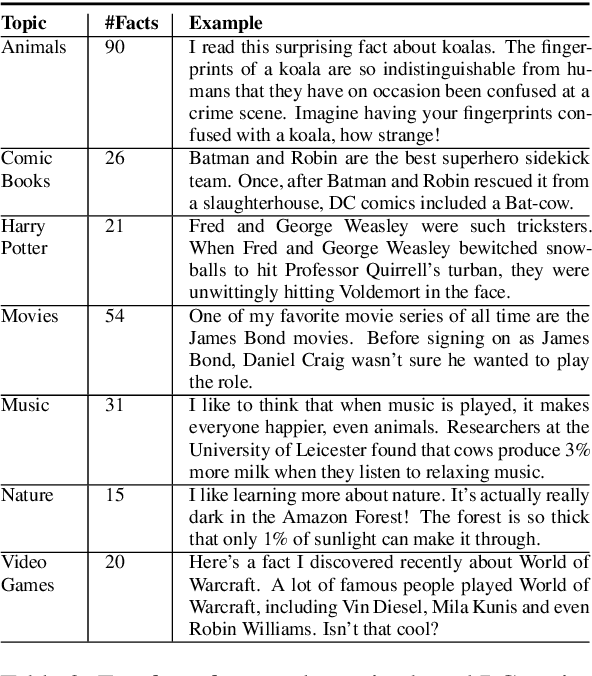
Abstract:Athena 2.0 is an Alexa Prize SocialBot that has been a finalist in the last two Alexa Prize Grand Challenges. One reason for Athena's success is its novel dialogue management strategy, which allows it to dynamically construct dialogues and responses from component modules, leading to novel conversations with every interaction. Here we describe Athena's system design and performance in the Alexa Prize during the 20/21 competition. A live demo of Athena as well as video recordings will provoke discussion on the state of the art in conversational AI.
Masked COVID-19 Trends from Social Media
Oct 30, 2020



Abstract:COVID-19 has affected the entire world. One useful protection method for people against COVID-19 is to wear masks in public areas. Across the globe, many public service providers have mandated correctly wearing masks to use their services. This paper proposes two new datasets VAriety MAsks - Classification VAMA-C) and VAriety MAsks - Segmentation (VAMA-S), for mask detection and mask fit analysis tasks, respectively. We propose a framework for classifying masked and unmasked faces and a segmentation based model to calculate the mask-fit score. Both the models trained in this study achieved an accuracy of 98%. Using the two trained deep learning models, 2.04 million social media images for six major US cities were analyzed. By comparing the regulations, an increase in masks worn in images as the COVID-19 cases rose in these cities was observed, particularly when their respective states imposed strict regulations. Furthermore, mask compliance in the Black Lives Matter protest was analyzed, eliciting that 40% of the people in group photos wore masks, and 45% of them wore the masks with a fit score of greater than 80%.
A Cross-lingual Natural Language Processing Framework for Infodemic Management
Oct 30, 2020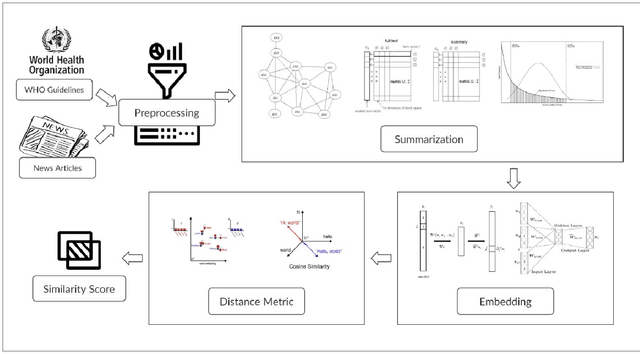
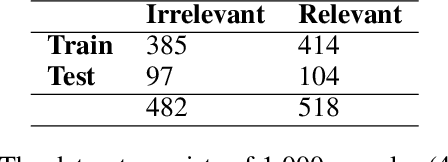
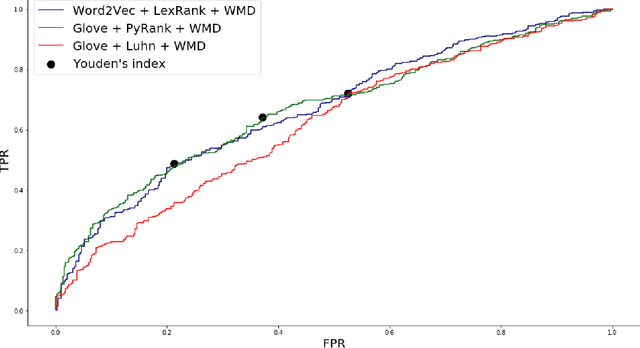
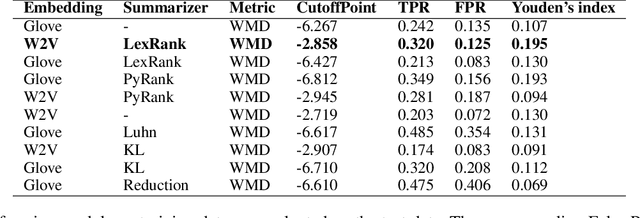
Abstract:The COVID-19 pandemic has put immense pressure on health systems which are further strained due to the misinformation surrounding it. Under such a situation, providing the right information at the right time is crucial. There is a growing demand for the management of information spread using Artificial Intelligence. Hence, we have exploited the potential of Natural Language Processing for identifying relevant information that needs to be disseminated amongst the masses. In this work, we present a novel Cross-lingual Natural Language Processing framework to provide relevant information by matching daily news with trusted guidelines from the World Health Organization. The proposed pipeline deploys various techniques of NLP such as summarizers, word embeddings, and similarity metrics to provide users with news articles along with a corresponding healthcare guideline. A total of 36 models were evaluated and a combination of LexRank based summarizer on Word2Vec embedding with Word Mover distance metric outperformed all other models. This novel open-source approach can be used as a template for proactive dissemination of relevant healthcare information in the midst of misinformation spread associated with epidemics.
 Add to Chrome
Add to Chrome Add to Firefox
Add to Firefox Add to Edge
Add to Edge